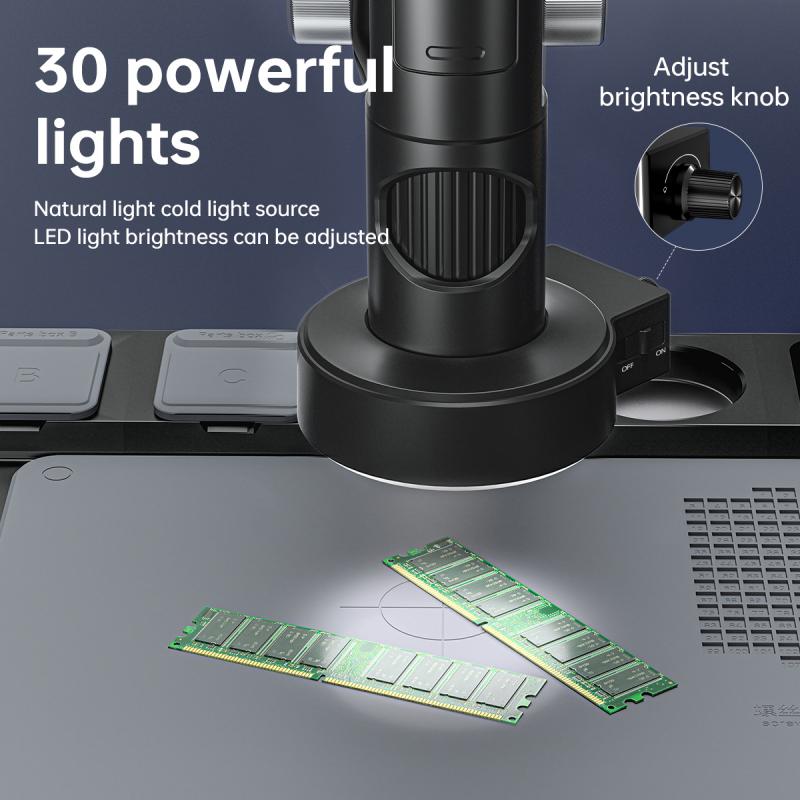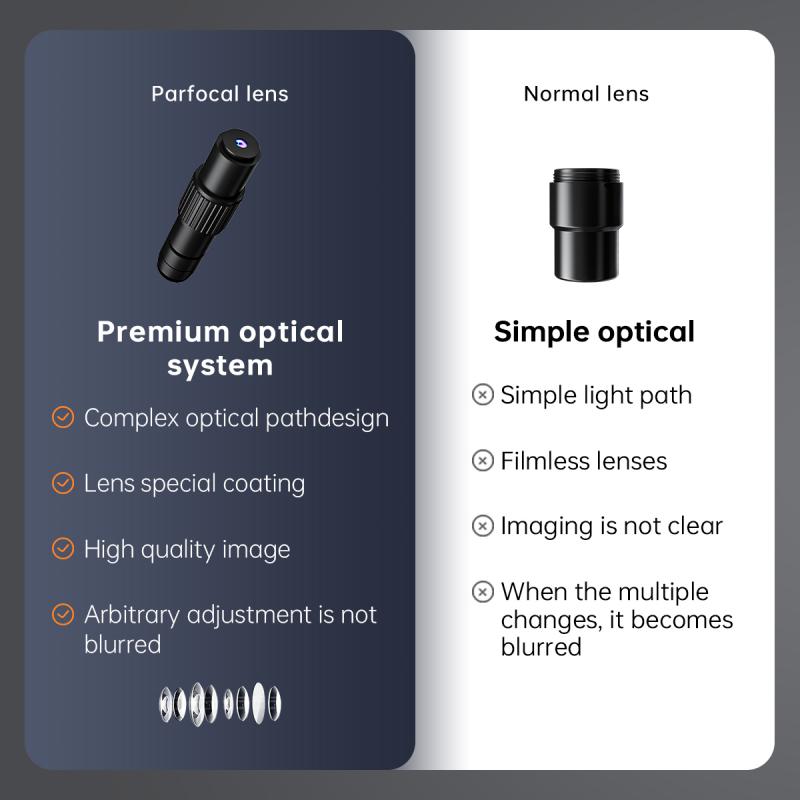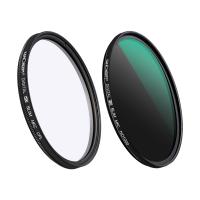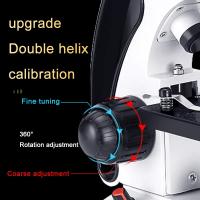What Can Be Seen Under A Light Microscope ?
Under a light microscope, one can see a variety of biological specimens such as cells, tissues, and microorganisms. The magnification of a light microscope ranges from 40x to 1000x, allowing for the visualization of structures that are not visible to the naked eye. Cells can be observed in detail, including their shape, size, and internal structures such as the nucleus, mitochondria, and cytoplasm. Tissues can also be examined, revealing the arrangement of cells and extracellular matrix. Microorganisms such as bacteria, fungi, and protozoa can be observed, providing insight into their morphology and behavior. Additionally, other biological specimens such as blood cells, plant cells, and animal tissues can be viewed under a light microscope.
1、 Cell structure and organelles
Under a light microscope, cell structure and organelles can be seen. The light microscope is a powerful tool that allows scientists to observe the intricate details of cells and their components. The cell is the basic unit of life, and it is composed of various organelles that perform specific functions. These organelles include the nucleus, mitochondria, endoplasmic reticulum, Golgi apparatus, lysosomes, and cytoskeleton.
The nucleus is the control center of the cell and contains the genetic material, DNA. Mitochondria are responsible for producing energy for the cell through cellular respiration. The endoplasmic reticulum is a network of membranes that is involved in protein synthesis and lipid metabolism. The Golgi apparatus is responsible for modifying, sorting, and packaging proteins and lipids for transport to their final destinations. Lysosomes are involved in the breakdown of cellular waste and foreign substances. The cytoskeleton provides structural support and helps with cell movement.
Recent advancements in light microscopy have allowed for even greater resolution and clarity in observing cell structure and organelles. Super-resolution microscopy techniques, such as stimulated emission depletion (STED) microscopy and structured illumination microscopy (SIM), have enabled scientists to observe structures at the nanoscale level. This has led to new discoveries and a deeper understanding of cellular processes and functions.
In conclusion, the light microscope is a valuable tool for observing cell structure and organelles. With recent advancements in microscopy techniques, scientists can now observe these structures at even greater resolution and gain a deeper understanding of the complex processes that occur within cells.

2、 Tissue architecture and organization
Under a light microscope, tissue architecture and organization can be seen in great detail. This includes the arrangement of cells, extracellular matrix, and blood vessels within the tissue. The cells themselves can be observed in terms of their size, shape, and organization into layers or clusters. The extracellular matrix, which provides structural support and regulates cell behavior, can also be visualized.
In recent years, advances in imaging technology have allowed for even greater resolution and detail in the observation of tissue architecture and organization. For example, confocal microscopy allows for the visualization of specific structures within cells, such as organelles and cytoskeletal elements. Additionally, techniques such as immunofluorescence staining and electron microscopy can provide further insight into the molecular composition and ultrastructure of tissues.
Understanding tissue architecture and organization is crucial for a variety of fields, including medicine, biology, and engineering. In medicine, knowledge of tissue structure is essential for diagnosing and treating diseases, as well as developing new therapies. In biology, understanding tissue organization is important for studying development, regeneration, and disease processes. In engineering, knowledge of tissue architecture is critical for designing and developing biomaterials and tissue-engineered constructs.
Overall, the study of tissue architecture and organization under a light microscope provides a foundation for understanding the structure and function of tissues in health and disease. With continued advances in imaging technology, we can expect to gain even greater insight into the complex organization of tissues and their role in biological processes.

3、 Microbial morphology and motility
Under a light microscope, microbial morphology and motility can be observed. Microbial morphology refers to the physical appearance of microorganisms, including their shape, size, and arrangement. Bacteria can be classified into different shapes, such as cocci (spherical), bacilli (rod-shaped), and spirilla (spiral-shaped). Fungi can also be observed under a light microscope, and their morphology can vary from unicellular yeasts to multicellular molds.
Motility refers to the ability of microorganisms to move. Some bacteria have flagella, which are whip-like structures that allow them to move through liquid environments. Other bacteria can move by gliding or twitching. Protozoa, which are single-celled eukaryotic organisms, can also be observed under a light microscope and can exhibit various forms of motility, such as cilia or flagella.
Recent advancements in microscopy techniques have allowed for even greater resolution and visualization of microbial morphology and motility. For example, super-resolution microscopy techniques such as structured illumination microscopy (SIM) and stimulated emission depletion (STED) microscopy have enabled researchers to observe microbial structures at the nanoscale level. Additionally, live-cell imaging techniques such as fluorescence microscopy and confocal microscopy have allowed for the observation of microbial motility in real-time.
Overall, the light microscope remains a valuable tool for studying microbial morphology and motility, and recent advancements in microscopy techniques have further expanded our understanding of these microorganisms.

4、 Blood cell types and abnormalities
Under a light microscope, blood cell types and abnormalities can be seen. Blood cells are classified into three main types: red blood cells (erythrocytes), white blood cells (leukocytes), and platelets (thrombocytes). Red blood cells are the most abundant and are responsible for carrying oxygen throughout the body. They appear as small, biconcave discs with a pale center. White blood cells are less abundant and are responsible for fighting infections. They appear as larger cells with a nucleus and can be further classified into different types based on their appearance and function. Platelets are responsible for blood clotting and appear as small, irregularly shaped cells.
Abnormalities in blood cells can also be seen under a light microscope. For example, sickle cell anemia is a genetic disorder that affects the shape of red blood cells, causing them to become crescent-shaped and less efficient at carrying oxygen. Leukemia is a type of cancer that affects white blood cells, causing them to grow and divide uncontrollably. Other abnormalities that can be seen include anemia, which is a decrease in the number of red blood cells, and thrombocytopenia, which is a decrease in the number of platelets.
It is important to note that while a light microscope can provide valuable information about blood cell types and abnormalities, it has its limitations. For example, it cannot detect certain types of infections or genetic mutations that may affect blood cells. In recent years, advances in technology have led to the development of more sophisticated techniques for analyzing blood cells, such as flow cytometry and genetic testing. These techniques can provide more detailed information about blood cell function and help to diagnose and treat a wider range of conditions.







































